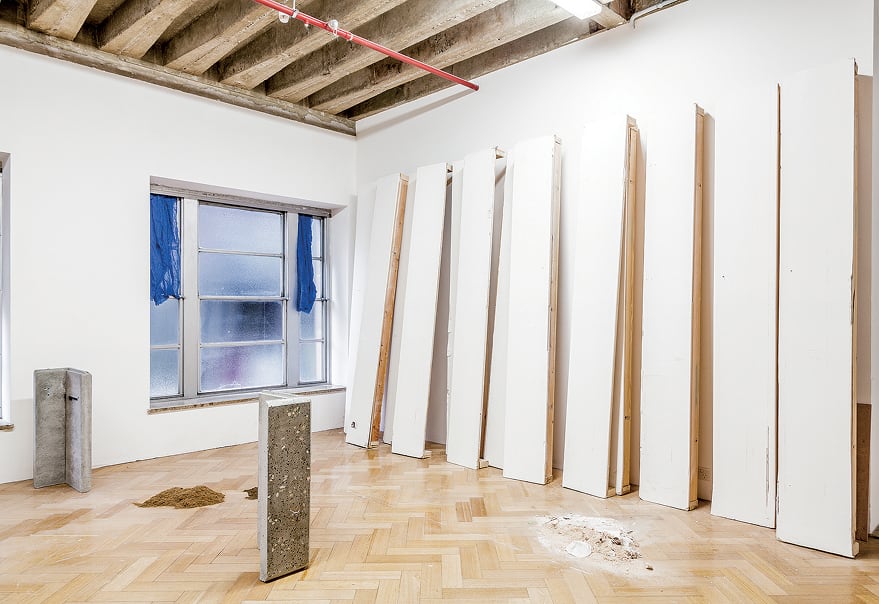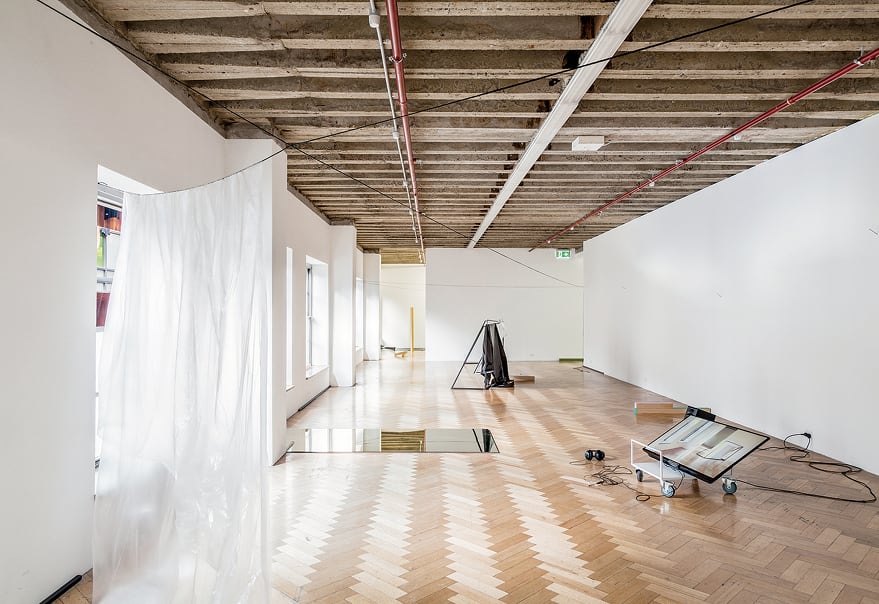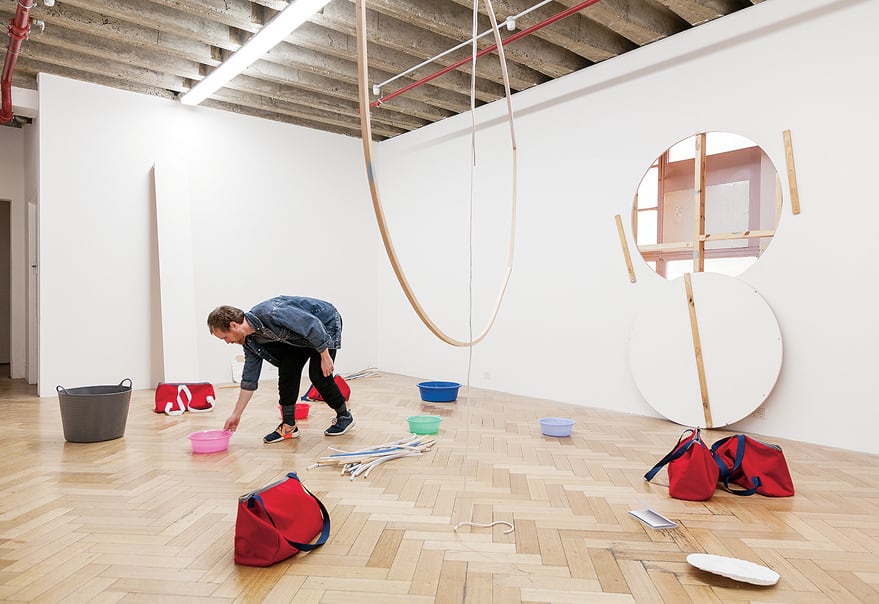The recent exhibitions of Melbourne artists Benjamin Woods, Georgina Criddle and Helen Grogan, consecutively programmed at West Space in 2015, can be seen to crystallise certain tendencies in contemporary local spatial practice. The current conversation around these projects centres on how they bring to the fore the dynamic but overlooked relations between objects, bodies and forces within the space of the gallery through, for example, open windows, a ‘wall clock’ or shifting bags and buckets. In focusing on these practices together rather than individually, how might we interpret a repetition or consolidation of certain gestures? Taking feminist and queer theorist Sara Ahmed’s understanding of ‘orientation’ alongside political theorist Chantal Mouffe’s concept of the political role of art, this essay seeks to elaborate the possible limits of this collective emphasis on process, embodied attention and pluralism in order to interrogate their political effects.

The first of the three overlapping exhibitions, Helen Grogan’s
THREE ADJOINING SPACES WITH MANIFOLD EDGES (29 May – 4 July) spanned three galleries and included a shifting field of sculptural elements: steel frames, black floor matting, draped plastic sheets, a large mirror, and the gallery windows — usually closed and opaque, now open. Propped against the wall or on a trolley, two video monitors displayed long takes of the subtle shifts in light and shade across the gallery space and adjacent city buildings. A month later, Georgina Criddle’s
Before Too Long (10 July – 26 September) enacted a transformation of the Back Space into an L-shaped corridor. On returning towards the end of the ten-week long exhibition, the viewer found that Criddle had been marking time by gradually removing sections of the structure to reveal the interior spaces of the wall — now home to an array of beer cans, banksia flowers, concrete slabs and various other objects — with a weekly newsletter documenting the artist’s activities, research and everyday encounters. Walking into Gallery 2, an A4 text stuck to the wall invited the viewer to borrow one of the red or blue bags dispersed with other small sculptures across the floor of the space; this comprising one part of Benjamin Woods’
that which enables and constrains what can and cannot be done or said (21 August – 26 September). Turning around, a circular cut in the wall revealed an otherwise hidden interior window and, in the adjoining room, a small book of text and collages sat near a video of buckets being moved around the gallery floor.

Across their specific materials and methods, the projects collectively seek to rearticulate the space of the gallery as a site of process, plurality and what writer Sarinah Masukor terms an ‘embodied observation’, working to ‘direct the viewer to elements of space that frequently go unnoticed’. By attuning our perception to the shifts occurring in and across the architecture, the artworks reveal that the gallery space cannot be figured as the passive or static backdrop to the activity of art, but is itself a material constantly in process. In addition to continually altering and reinstalling the physical components of the work, the artists aim to remain open to the dynamic interplay and agency of a multiplicity of objects and nonhuman forces; among which the viewer is figured as an active and embodied participant. Given these ongoing changes, the document in its various forms is key to how the work is accessed, and is actively enfolded into the present experience of the project.
The accumulation of these gestures can be thought of as forming a certain type of orientation. The effect of their repetition orientates us, artists and viewers alike, toward particular ways of inhabiting and attending to space. Turning to Ahmed, the question then becomes, what is this specific orientation — in what ways have bodies and spaces been aligned within these exhibitions? When a certain orientation becomes habitual, it can cease to be an object of our perception, and so it is important to remember that ‘what we face can also be part of the background’ — that these tendencies depend on taking certain points of view as given. As any direction is taken at the exclusion of possible others, what might have to fade from view
behind these artworks in order to develop this shared orientation toward space? What bodies are able to extend into these spaces and control the action that takes place there? Through a focus on specific aspects of their practices, I hope to draw out the political nature of this collective orientation, and to begin questioning how our attention is directed toward certain ways of understanding and occupying space at the expense of others.

To begin, we can look at the specific role of the artist that is being put forth in these projects. In positioning the artworks as a catalyst for the dynamic interaction of human and nonhuman forces, the artists call upon a notion of practice as an openness to pluralism, such that the artist takes on the role of ‘an accommodator and participant simultaneously, rather than as a director or instructor’. From the acknowledgements (Thank you…) of friends and collaborators in the expanded titles of Woods’ collages, to the accommodating nature of Georgina Criddle’s work — a ‘glorified storeroom’ in which miscellaneous objects ‘just accumulated’ or ‘made their way’ — the artist is framed as just another participant in the making of the work. However, this pluralism can be contested and the latent agency of objects undermined by the need for ‘Example Action Sessions’ (Woods) or ‘concerts’ (Grogan) to embody and activate them. It is implicit that the artist still delimits the field of possible action and only some bodies are allowed to complete certain actions: Criddle is ‘shocked’ when someone rolls one of her objects into another artist’s space, and only Grogan has the authority to open (or close) the windows of the gallery. Pluralism is espoused — yet only so long as the artist is present to condone it.
In their preoccupation with the framing and duration of experience, the artworks rely on ‘a theatrical effect or quality — a kind of
stage presence’. In Grogan’s exhibition, the recurring open rectangular form and endless re–inscription of documentary traces reduce the spatial installations to a
mise en scène of two dimensional framing devices arranged for the camera. This primacy of vision is replaced in Criddle’s work with the authority of the newsletter, which frames — or scripts — the movements and meanings of the objects and participants therein. Further, if the room is ‘always already performing’ then far from de-accentuating the role of the artist, this again only brings them to the fore. The logic of each work as it unfolds in a continuous present (always ‘doing’ never fully ‘done’) and so requires the almost constant presence of the artist to keep updating it. In this way, the artist is the manager of the performance — directing the action, capturing the space at its best angles and deciding which aspects of the room’s performance will be represented to the viewer. This is not just a matter of what Elena Betros describes as ‘bringing the details of what was already there forward and into view’, as the act of framing is neither casual nor arbitrary but rather the outcome of precise decisions made by the artist regarding the presence or absence of certain bodies, objects and actions in the space. Accordingly the question becomes, rather than simply opening up new perspectives, how could this paradigm of exhibitions that change constantly through intense artistic labour align with the neoliberal imperative of unceasing performativity?
This practice of management involves not only directing and facilitating participation but also minimising risk. Across the three exhibitions, signs of conflict are evoked and aestheticised — Woods’ circular cut in the wall, for example, recalls the formal aspects of Gordon Matta-Clark’s
Conical Intersect (1975) without bringing forward any of its associated artistic or political risk. Rather than a potential tension, the opposites at play in the title of Woods’ exhibition (simultaneously enabling and constraining) seem to express the utopic attempt to encompass all options — for an endlessly
open spatial practice. Grogan’s titles display a similar ‘insistence on plurality’, and the newsletter
Nods All Round, where Criddle celebrates the consensus of a group of artists discussing a social issue, is an example of the artist’s consistent politics of welcoming. Although each artist points to the non–containment of the artwork by institutional space, in what more profound ways could they expand beyond the limits of the gallery walls? Although I agree with Woods that ‘practice is inherently collaborative and local within a community’, it is important to ask who is the public that the work
could call into being beyond this community, as a public that this work inherently must address.
This is where the political implications of these works can no longer be ignored, for while plurality is no doubt as necessary to artistic practice as it is to social struggles, Mouffe insists that it can never be reconciled into a ‘harmonious and non-conflictual ensemble’. As a form of public and therefore political discourse — a terrain of conflicting desires where different forms of articulation strive to become dominant — artistic practice cannot elide the inescapable moment of decision, of choosing a certain orientation at the exclusion of others. Critical art, according to Mouffe, can function to challenge and transform normative understandings of material and social relations, and in doing so offer ‘spaces for resistance that undermine the social imaginary necessary for capitalist reproduction’.
The crucial question then concerns possible forms of
critical spatial practice. Each project raises compelling questions regarding the possibility of an embodied engagement with space within and beyond the gallery, but it is necessary to interrogate how these intentions are enacted. If destabilising the authorial role of the artist is a collective concern, then how might these practices engage the participation of others beyond an invitation to borrow a bag, watch a video or read a newsletter? If spatial practice considers itself open, how might artists call into question the limits of access and control to spaces, objects and discourses across a multiplicity of sites? Spatially oriented art practice can be a debate about possible alternatives to conventional understandings of the relation between space, artist and viewer, but this requires a critical interrogation of what is being challenged — and what is being risked.
Emily Castle is a writer and artist from Melbourne.
[^14]: Ibid, p. 88.



